Screens for the kitchen: types, designs and tips for choosing
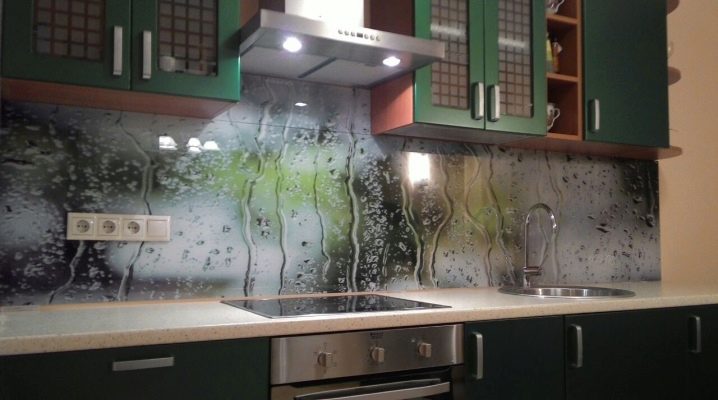
Few kitchens can do without a screen in the sink, stove and work area. It serves two important functions. The first is to protect the wall covering from food contamination, water, steam, and fire. For this, it is also called an apron. The second function is decorative. In this case, the screen serves as a decoration for the kitchen and a logical complement to the kitchen furniture. Usually they begin to choose it at the stage of planning a renovation or order it together with kitchen furniture. Fortunately, now there are many varieties of such protection. At the same time, this further complicates the choice, so you need to approach it after carefully studying all the available information.
Varieties
The biggest difference between the types of screens is the material from which they are made. Each material has its own characteristics and capabilities that affect their appearance and other qualities. Be sure to take into account other characteristics: strength, installation method, heat resistance, durability, practicality, etc.
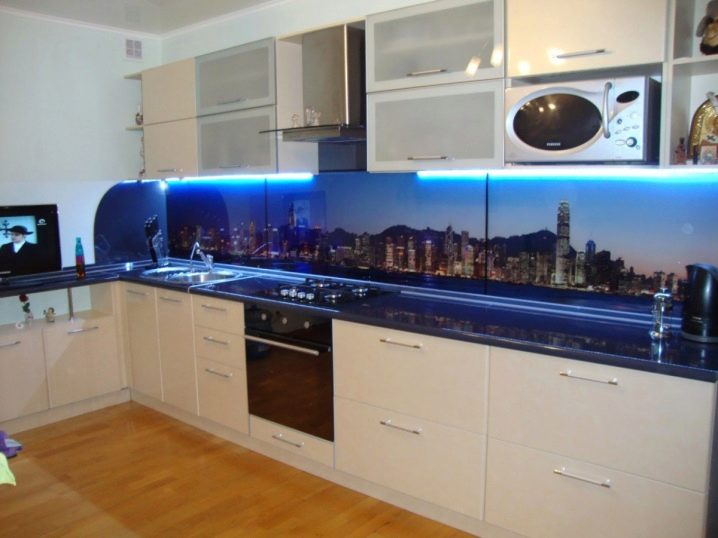
MDF
The most common option for kitchen screens today. MDF is the basis, on top most often a coating of polyvinyl chloride is applied - plastic or a thinner film to match the countertop. Of its advantages, the following can be noted:
- practicality (if there are edges from the ends, the screen does not absorb water splashes, drops of fat and is well washed);
- availability (compared to other options, the cost is quite low);
- the lightness of the product itself, despite its large dimensions;
- does not require wall preparation;
- even if the repair has already been done, the screen is installed simply, quickly and without dust;
- can be easily replaced with a new one even on your own;
- a huge selection of colors and textures (wood, stone, textiles, metal).

Among the disadvantages are:
- low resistance to damage, short service life;
- the possibility of mold or mildew formation between the wall and the screen;
- deforms in case of contact with a heated object or open fire (such a screen is contraindicated if the hob with the highest power is located at the back or a wide heated cookware will come into contact with it).
Another option for coating based on MDF is paper with photo printing and acrylic coating. At first glance, such a screen looks like a glass one. Has the same pros and cons as the plastic cover. Manufacturers usually have catalogs where you can choose a suitable image.

Glass
Another variety is polycarbonate or tempered glass screens. Tempered glass is several times stronger than ordinary glass, as well as:
- it is a thermal protective material, it does not change under the influence of moisture;
- can be used for a long time;
- it is easy to care for, and when choosing a certain design, contamination is almost invisible.
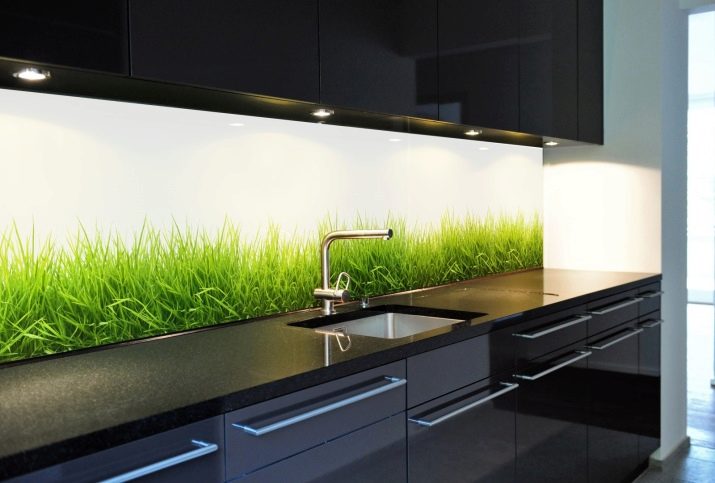
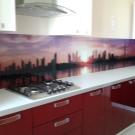
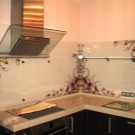
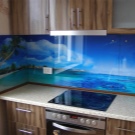
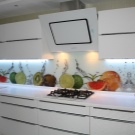

Its installation requires special skills. Such a screen does not withstand strong impacts and may crack.
There are different types:
- completely transparent or translucent;
- colored (painted);
- with shine, satin or mirror.
The pattern appears as a result of photo printing or by applying a film to the inside. The first option is more expensive, but it can be anything from landscapes to portraits. In the second case, the possibilities are more modest, but it is more accessible.
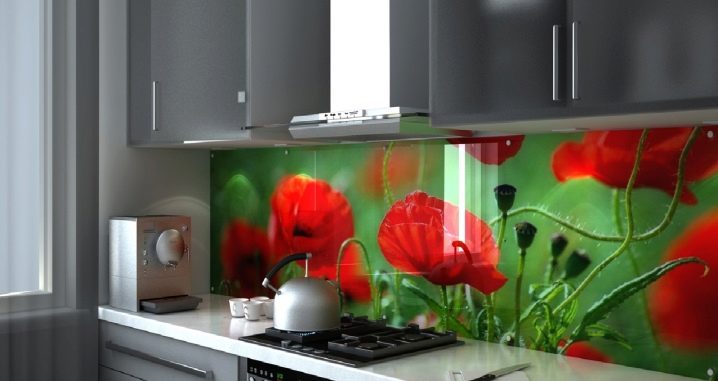
Ceramics
The most common option for decorating a working wall in a kitchen is laying out with ceramic tiles (or tiles). This wall covering is not afraid of food pollution, humidity, high temperatures. The tile will last for many years and with proper care (and it can be easily washed) it will look just as good without losing its useful properties. Tiles have a fairly large selection, both in size and appearance. It can be shiny or matte, smooth or embossed, with drawings, patterns, imitation of natural materials, mosaics and other effects.

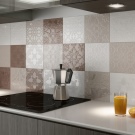
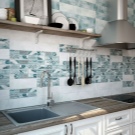
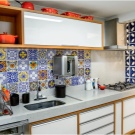


It should be understood that the seams between the tiles will disrupt the holistic perception, plus they need additional cleaning. The main difficulties arise at the stage of preparing the walls and the installation itself. It is difficult to do this without experience, as well as changing tiles. Dismantling requires a lot of time, effort and a lot of cleaning. The tiles are quite heavy and require effort during transportation. It can crack if exposed to a point mechanical impact.
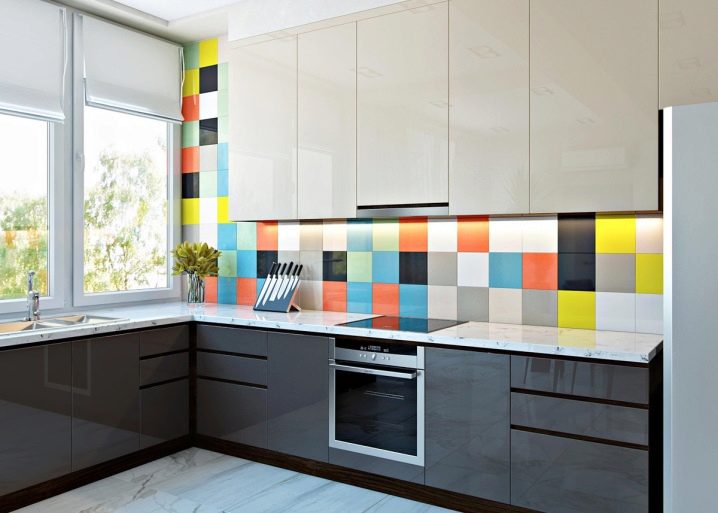
But with tiles, you can decorate not only the space between the upper and lower sections of the kitchen, but also lay out the space under the hood or the entire wall as a whole, which is more practical.
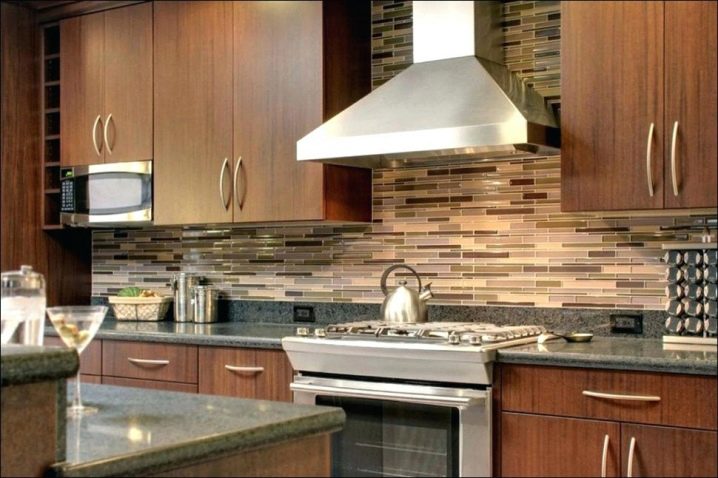
Metal
Initially, stainless steel screens were used in catering establishments. Now they are increasingly used in the interior of home kitchens. There are many reasons for this:
- durability;
- resistance to dirt and hygiene;
- stainless steel does not deteriorate due to moisture or heat;
- goes well with other materials;
- can be either simply polished or with various patterns - in the form of mosaics, floral, abstract and geometric patterns.
Both tiles and large wall panels are made of metal. To clean them, you need special products, since abrasives can damage the surface.

Stone
A stone wall panel is usually ordered as an addition to the same countertop. Although natural stone looks great, only a narrow circle of people can afford it. Therefore, its artificial counterpart is most often found. The choice of colors is quite wide - there are pure colors, as well as blotches, stains and even sparkles. The wall panel looks particularly impressive with internal LED lighting. Of the advantages, it can be noted:
- the ability to cast a panel of the desired shape or grind all joints so that it looks solid;
- resistance to mechanical, chemical and thermal stress;
- ease of restoration in case of damage (thanks to grinding);
- strength, long service life.

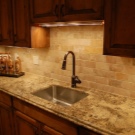
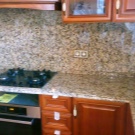

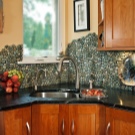
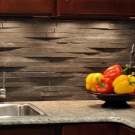
Due to its heavy weight and large dimensions, the services of specialists will be required for delivery, lifting and installation.

Plastic
You can find protective screens made entirely of plastic. They have a number of obvious advantages:
- they are waterproof;
- lightweight and very easy to stick in the right place;
- have a large number of decor options - there are smooth models, with imitation of tiles, stone or wood, with various images;
- they are the cheapest of all (available from most building supermarkets).
These plastic panels are very thin and break easily. For their manufacture, plastic is used, which can easily melt or change color when heated. Such panels quickly fade, and under the influence of cleaning agents, a poorly applied color layer can be rubbed off.
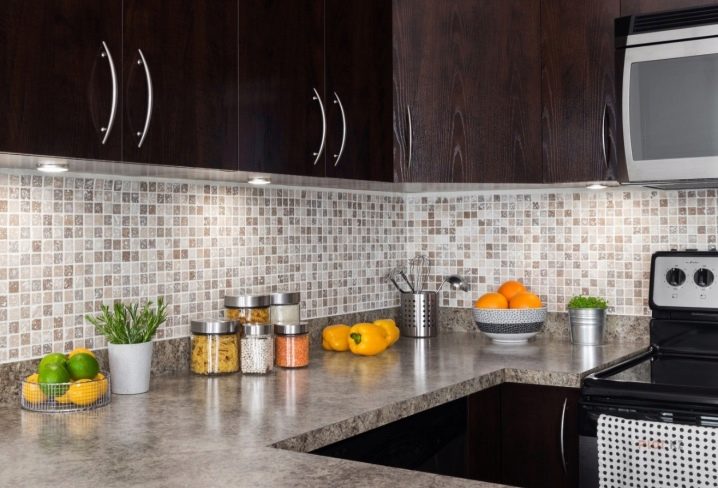
Wood
A wooden screen is rarely installed on the working area. Unless only for purely aesthetic purposes. In order for the tree to be more or less resistant to pollution and not to dry out, it must be treated with oil. It needs special care and maintenance of the same humidity level in the kitchen. In reality, this is almost impossible if only the kitchen is used infrequently.
The natural beauty of the tree is undeniable; it is synonymous with respectability. Its naturalness is also highly valued - the tree does not have a negative effect on the body. It is possible to eliminate shallow defects, again by grinding. The cost of such a product will be very high, which is why all kinds of wood-based panels are used instead.
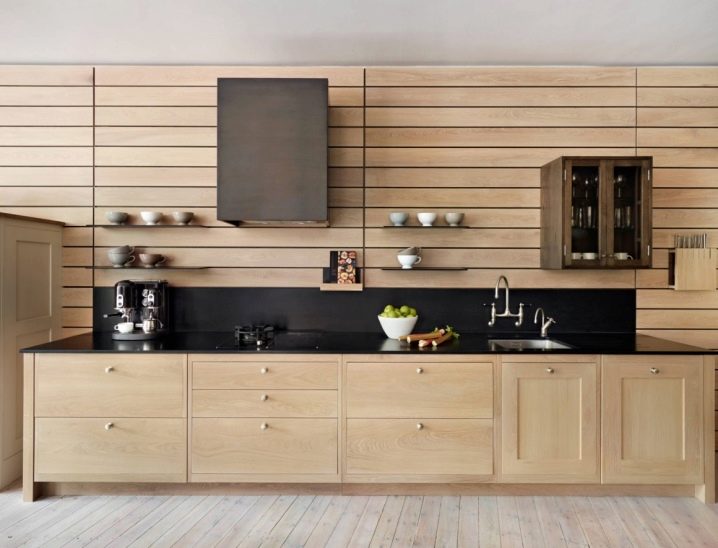
Design ideas
For a kitchen to look truly stylish, it must have the correct color accents and the proportions between all of its parts. You can use a universal technique - use neutral colors for furniture, floors, walls and ceilings, diluting all this with colored objects. One of them will be the screen. It must necessarily overlap with something else - for example, dishes, lighting, textile decor. So, even a combination of several bright colors will not look defiant.
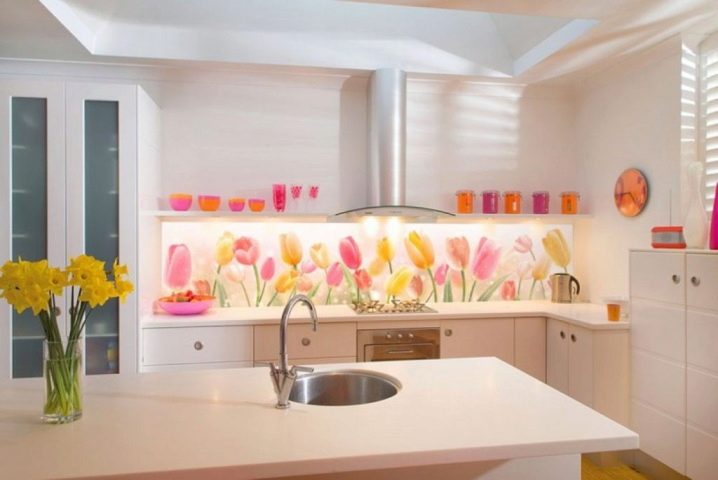
White interiors always remain relevant. It will not be boring if you use a tile screen or embossed canvas. If you plan to use a screen with a contrasting color (black, red, purple), it is better if it is matte.
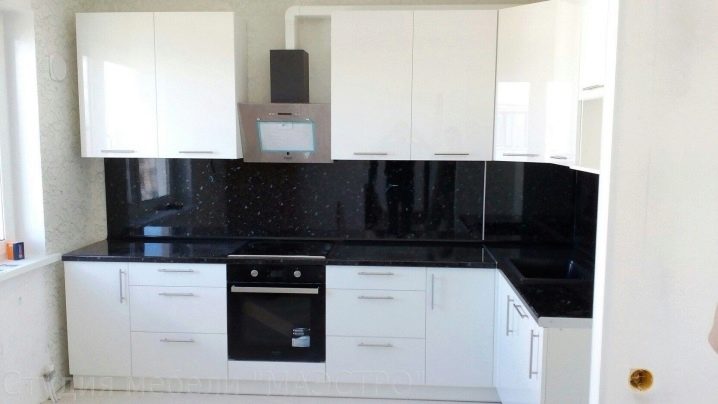
Considering the line of kitchens, where the main one is white, you can dwell on the design in the Scandinavian style. The screen in such a kitchen can be brown, coffee, blue - any of the line of calm natural shades.
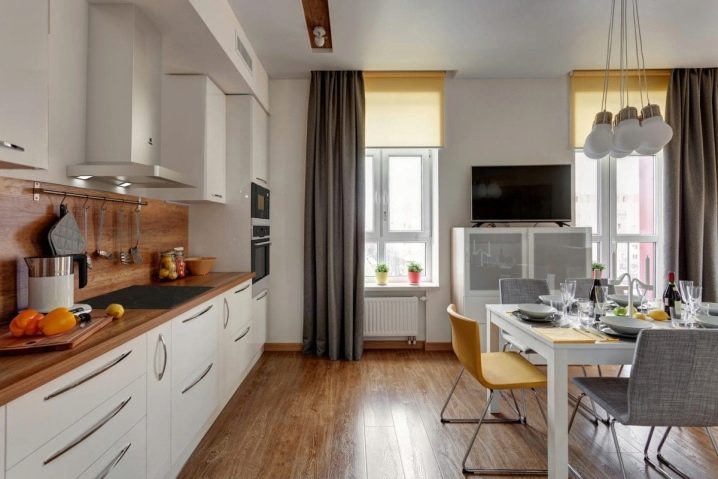
Today, to protect the wall of the working kitchen area, it is fashionable to use a combination of several types of tiles - different in color, relief or pattern. For such a combination to be harmonious, it is important that they are similar in style. Do not forget that all interior items should be interconnected. In some models of screens that imitate raw stone, sea reed, some wood species, several shades are combined at once. One or two of them can be used to decorate a kitchen set.
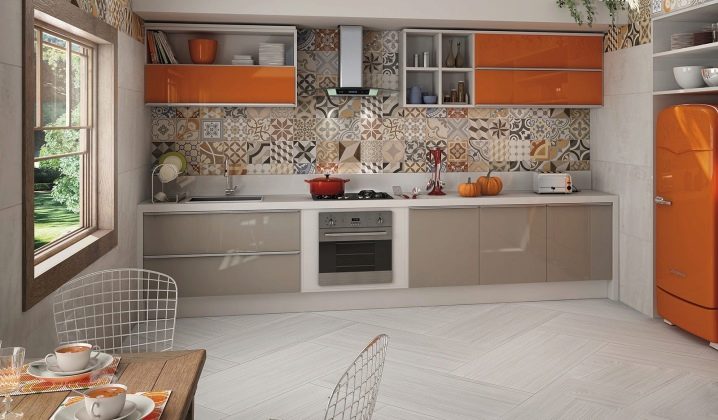
Selection rules
- Keep in mind that streaks and streaks will be more noticeable on a glossy surface with saturated colors. For practicality, choose light colors and fine patterns without shine.
- Smaller tiles look better in this case. According to the rules of laying out, it should go behind the upper cabinets and the countertop. If there are few seams, they should be symmetrically located.
- The screen can cover not only the space above the worktop, but also continue it in the hood area. And also decorate the entire wall or even use on other walls.
- All cuts and holes in the glass are made only in production. It will no longer be possible to change them. Therefore, after the measurement, do not carry out any work on the walls.
- Be sure to consider how the ends (cuts) look, if they will be visible.
- Don't skimp on installation. Professionals should work with expensive and fragile materials - so the result will be truly beautiful.
- Some versions of screens that run with a large canvas can be installed exclusively on flat walls. First, gaps may remain. And secondly, materials that do not bend, with a large curvature of the walls, will be difficult to fix.
- When ordering, be sure to specify the maximum parameters of the canvas for screens. This is necessary to take into account the number of joints between the parts.
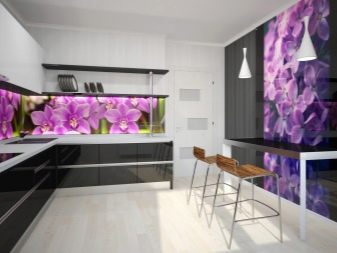
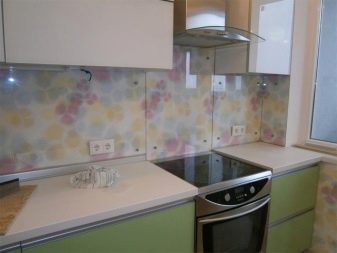
See the video below for the installation of a glass kitchen apron.













The comment was sent successfully.